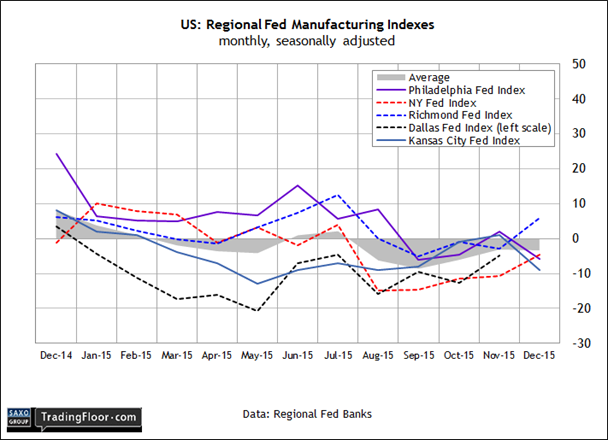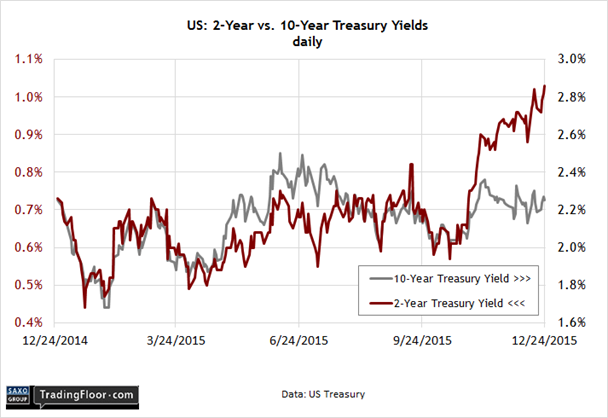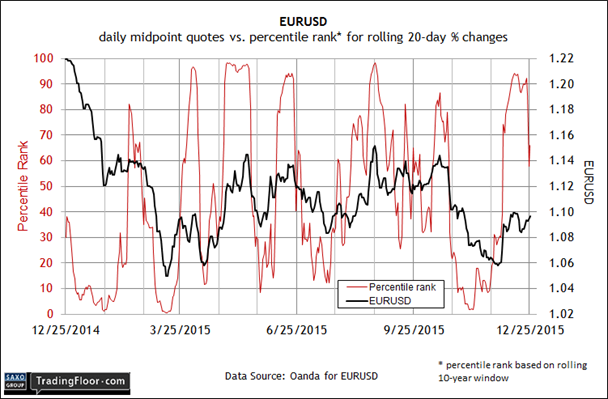The last week of 2015 is off to a slow start for economic news. The main event for formal releases is the US data via the Dallas Fed’s December report on manufacturing activity in the bank’s region. Meanwhile, keep your eye on two key markets as questions about economic growth and monetary policy continue to buffet expectations: the 2-year Treasury yield and EUR/USD.
US: Dallas Fed Manufacturing Index (1530 GMT) Last week brought some encouraging news for the US economy. Personal spending and income rose at respectable rates in November and initial jobless claims dipped for the week through December 18, sticking close to a multi-decade low. Meanwhile, consumer sentiment ticked higher in the year’s final month, reaching the highest level since July, according to survey data from the University of Michigan.
But holiday cheer was tempered with news that the Atlanta Fed’s revised estimate for fourth-quarter GDP fell to a weak 1.3% in the December 23 revision. Economists, by contrast, still expect a stronger pace of growth for Q4, but it’s fair to say that there’s a distinct lack of joy in the current round of macro forecasts for the near term.
One reason for keeping expectations in check is the ongoing weakness in manufacturing. The ISM Manufacturing Index fell into contractionary territory in November for the first time in three years. Meanwhile, last week’s news of flat durable goods orders last month imply that factories will close out the year on a weak note once all the hard-data updates are in.
The regional manufacturing indexes published by the Fed banks don’t look encouraging either. The Richmond Fed’s headline index rebounded with a growth reading this month for the first time since August, but otherwise contraction still dominates.
Today’s December report from the Dallas Fed isn’t expected to offer any relief from the negative bias of late. The crowd’s looking for a modestly deeper shade of red in the general activity index, which is projected to slip to -6.0 from November’s -4.9 reading, according to Econoday.com’s consensus forecast. If the prediction holds, we’ll have one more reason to think that a manufacturing rebound is still nowhere on the horizon.

U.S. 2-Year Treasury Yield The 2-year Treasury yield cracked the 1% barrier again last week. For only the second time in nearly six years, this key maturity on the yield curve—widely seen as the most sensitive for rate expectations—rose above that round number, ticking up to 1.03% at last week’s close, based on daily data from Treasury.gov.
Staying above the 1% mark, much less rising further, may be difficult, based on the downward revision in the Atlanta Fed’s estimate for fourth-quarter GDP that was released last week. The bank’s widely followed GDPNow model pared the outlook for growth in this year’s final three months to an annualized gain of just 1.3%—below Q3’s 2.0% pace and Q2’s strong 3.9% increase, as of December 23.
Yet the crucial tailwind that pushed the 2-year yield higher is this month’s Fed decision to raise its policy rate—the first round of monetary tightening since 2006, driven by the assumption that the recovery will stay robust. Will the incoming economic data provide sufficient cover for the central bank’s decision?
The slide in the Atlanta Fed’s Q4 GDP estimate certainly raises new questions about the wisdom of squeezing policy at this juncture. Roubini Global Economics last week dispensed a sceptical view as well, advising that the latest numbers on consumer spending and durable goods orders support the outlook for anticipating soft growth in Q4. The cautious forecast suggests a growing case for putting the Fed’s rate-hike plans on hold, the consultancy told clients.
What’s the market’s view? A 2-year yield above 1% implies that the crowd still expects that the Fed will continue to squeeze policy in 2016 and that growth will remain intact. By contrast, if we see a convincing dip below the 1% mark, it may be time to rethink expectations for monetary policy and the macro outlook … again.

EUR/USD Economic growth for the Eurozone overall has weakened in recent months, but economists see the trend stabilizing in the fourth quarter and into the new year. The median forecast for Q4 growth among economists surveyed by Focus Economics this month points to a 0.4% quarter-over-year rise, which is slightly above Q3’s 0.3% advance. Looking ahead to 2016, the 0.4% quarterly pace is expected to continue for the near term.
Now-casting.com’s lastest Q4 GDP estimate also points to a slightly firmer trend compared with projections in recent history. The anticipated growth rate for the final three quarters of 2015 ticked up to 0.36% vs. the previous quarter in Friday’s weekly update—the highest Q4 outlook since early October.
A 0.4% gain still equates with a mild expansion at best, but the current projections that call for a steady if sluggish recovery are an improvement after recent worries that the euro area was stumbling into another recession. The question is whether the euro’s firming against the US dollar this month will continue.
From a technical perspective, the 1.10 range for the EUR/USD looks like a ceiling at the moment. The single currency inched up to roughly 1.0976 as of December 26, close to a two-month high. In light of the latest economic forecasts, the crowd will be considering anew the topic of euro strength. Exhibit A: current expectations for GDP growth to remain stable in the 0.3%-to-0.45 range. As such, the question at the top of the agenda this week: can the euro continue to strengthen against the greenback, if only on the margins?
Earlier this month the US and the Eurozone appeared to be on sharply divergent paths, due in no small part to expectations of monetary easing by the European Central Bank and the now-confirmed forecast that the Federal Reserve would start raising interest rates. But in the final days of 2015, the euro area’s economy doesn’t look as weak as previously assumed while the US macro trend in Q4 may turn out to be softer than expected.
In other words, the idea that the euro may rally against the US dollar in the short term isn’t the contrarian notion that it was a few weeks ago. With that backdrop in mind, the crowd will be watching to see if EUR/USD can break through 1.10 in the days and weeks to come.

Disclosure: Originally published at Saxo Bank TradingFloor.com
